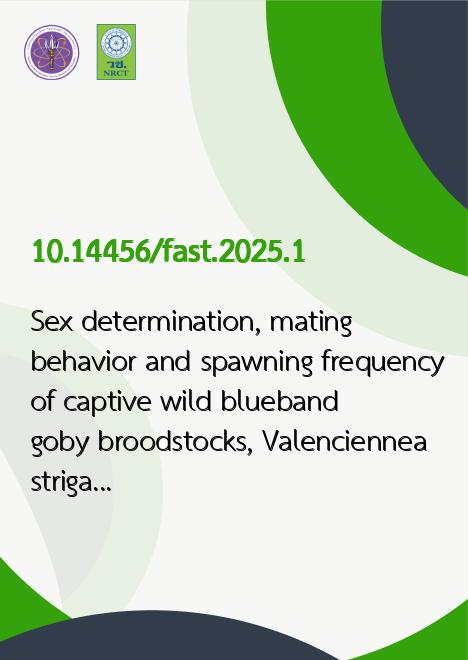
|
Sex determination, mating behavior and spawning frequency of captive wild blueband goby broodstocks, Valenciennea strigata |
|---|---|
| รหัสดีโอไอ | |
| Creator | Siriwan Choosri |
| Title | Sex determination, mating behavior and spawning frequency of captive wild blueband goby broodstocks, Valenciennea strigata |
| Contributor | Wilaiwan Phuangsanthia, Jarunan Pratoomyot |
| Publisher | Mahasarakham University |
| Publication Year | 2568 |
| Journal Title | Food Agricultural Sciences and Technology (FAST) |
| Journal Vol. | 11 |
| Journal No. | 2 |
| Page no. | 1-7 |
| Keyword | Blueband goby, mating behavior, sex determination, spawning frequency, Valenciennea strigata |
| URL Website | https://ph02.tci-thaijo.org/index.php/stej/index |
| Website title | Food Agricultural Sciences and Technology (FAST) |
| ISSN | 2822-1001 (Print), 2822-101X (Online) |
| Abstract | This research aimed to examine the sex determination, mating behavior, and spawning frequency of captive wild blueband goby broodstocks, Valenciennea strigata, under laboratory conditions. The experiment was conducted over a 12-month period in a hatchery at Bangsaen Institute of Marine Science, Chon Buri province, Thailand. Eight pairs of blueband goby broodstocks, derived from Chatuchak Market, Bangkok, were maintained in a biological recirculating system with tanks measuring 15 × 24 × 15 inches (70 liters of seawater). They were fed pelleted feed twice a day and supplemented with adult Artemia once a day for the duration of the study.Results revealed that the broodstocks had total weights ranging from 2.7 g to 19.4 g (average 5.8 ± 3.8 g) and total lengths between 7.1 cm and 13.8 cm (average 8.7 ± 1.5 cm) (n = 16). Sex determination showed that sex can be differentiated by the genital papilla: males have small sex polyps, and females have rounded sex lobes, along with a more open anus compared to males. These secondary sexual characteristics may be helpful in sexing blueband goby.Blueband gobies use external fertilization, with breeding behavior occurring in the evening after sunset, taking about 45 minutes to complete the laying process. The eggs were adhesive and oval-shaped, with sizes ranging from 1.0 mm to 1.1 mm in length and 0.3 mm in width. Spawning occurred every 10 to 12 days (10 ± 0.89 days) (n = 7), and the number of eggs ranged from 3,604 to 34,000 eggs (n = 5). The embryonic period lasted 56 hours and 30 minutes after fertilization. This study provides fundamental data that can serve as a guideline for raising blueband goby and other marine gobiidae. |